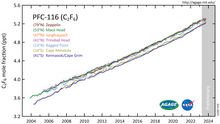Hexafluoroethane
| |||
| Names | |||
|---|---|---|---|
| Preferred IUPAC name
Hexafluoroethane | |||
| Other names
Carbon hexafluoride, 1,1,1,2,2,2-Hexafluoroethane, Perfluoroethane, Ethforane, Halocarbon 116, PFC-116, CFC-116, R-116, Arcton 116, Halon 2600, UN 2193
| |||
| Identifiers | |||
3D model (
JSmol ) |
|||
| ChEBI | |||
| ChEMBL | |||
| ChemSpider | |||
ECHA InfoCard
|
100.000.855 | ||
| EC Number |
| ||
PubChem CID
|
|||
RTECS number
|
| ||
| UNII | |||
| UN number | 2193 | ||
CompTox Dashboard (EPA)
|
|||
| |||
| |||
| Properties | |||
| C2F6 | |||
| Molar mass | 138.01 g.mol−1 | ||
| Appearance | Colorless odorless gas | ||
| Density | 5.734 kg.m−3 at 24 °C | ||
| Melting point | −100.6 °C (−149.1 °F; 172.6 K) | ||
| Boiling point | −78.2 °C (−108.8 °F; 195.0 K) | ||
| 0.0015% | |||
| log P | 2 | ||
Henry's law
constant (kH) |
0.000058 mol.kg−1.bar−1 | ||
| Hazards | |||
| NFPA 704 (fire diamond) | |||
| Flash point | Non-flammable | ||
| Supplementary data page | |||
| Hexafluoroethane (data page) | |||
Except where otherwise noted, data are given for materials in their standard state (at 25 °C [77 °F], 100 kPa).
| |||
Hexafluoroethane is the
Physical properties
Hexafluoroethane's
Table of densities:
| State, temperature | Density (kg.m−3) |
|---|---|
| liquid, −78.2 °C | 16.08 |
| gas, −78.2 °C | 8.86 |
| gas, 15 °C | 5.84 |
| gas, 20.1 °C | 5.716 |
| gas, 24 °C | 5.734 |
Vapor density is 4.823 (air = 1), specific gravity at 21 °C is 4.773 (air = 1) and specific volume at 21 °C is 0.1748 m3/kg.
Uses
Hexafluoroethane is used as a versatile
Together with trifluoromethane it is used in refrigerants R508A (61%) and R508B (54%).
It is used as a
Environmental effects


Due to the high energy of C−F bonds, hexafluoroethane is nearly inert and thus acts as an extremely stable
Hexafluoroethane did not exist in significant amounts in the environment prior to industrial-scale manufacturing. Atmospheric concentration of hexafluoroethane reached 3 pptv at the start of the 21st century.[5] Its absorption bands in the infrared part of the spectrum cause a radiative forcing of about 0.001 W/m2.
Health risks
Due to its high relative density, it gathers in low-lying areas, and at high concentrations it can cause
See also
- Octafluoropropane
- Tetrafluoroethene
- Hexachloroethane
References
- doi:10.1063/1.477806.
- ISBN 978-3-540-23215-5, S. 307.
- S2CID 23629379.
- ^ "Perfluoroethane CASRN: 76-16-4". TOXNET Toxicology Data Network. National Library of Medicine. 2016-10-25.
- ^ "Climate Change 2001: The Scientific Basis". Archived from the original on 2007-06-15. Retrieved 2007-06-02.
- Bozin SE, et al. (1968). "Growth of ionization currents in carbon tetrafluoride and hexafluoroethane". J. Phys. D: Appl. Phys. 1 (3): 327–334. S2CID 250891553.
External links
- Purification process of hexafluoroethane
- Protocol for measurement of tetrafluoromethane and hexafluoroethane from primary aluminium production
- De Maré, G.R.; Panchenko, Yu. N. (March 2006). "Ab initio vibrational analysis of hexafluoroethane C2F6". Journal of Structural Chemistry. 47 (2): 232–240. S2CID 96363970.
- Protocol for Measurement of Tetrafluoromethane (CF
4) and Hexafluoroethane (C
2F
6) Emissions from Primary Aluminum Production - Thermochemistry data table at chemnet.ru



